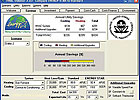It's not an exaggeration to say that this press release sent shock waves through the industry. Now that the dust is starting to settle in our 13 SEER world, current discussions in the industry are turning to stockpiling, marketing-sales techniques, and upselling strategies.
As far as stockpiling is concerned, contractors are coming to grips with the fact that some manufacturers, distributors, and other contractors are still offering 10 SEER equipment to customers. That approach doesn't do the customer any favors.
The economy in the Midwest, as well as some other areas of the country, is still sluggish, so contractors need to go back to the basics with their sales and marketing materials in order to overcome stockpiling concerns. Contractors who made the decision not to stockpile 10 SEER equipment seem to have a clearer understanding of the need for strong benefit statements and the importance of tried-and-true upsell techniques.
"We are relying on marketing and sales fundamentals to help customers understand the benefits of energy efficiency, the return on investment - the same as when selling high efficiency equipment in the past," said Pat Flory, Answer Heating & Cooling, Freeland, Mich.
BASICS INCLUDE BENEFIT STATEMENTS
Getting back to basics and relying on marketing and sales fundamentals is the best way to encourage consumers to do the right thing. "It's really a ‘gut check' for our marketing and sales efforts, and we're trying not to use words like ‘obsolete' when discussing 10 SEER," stated Flory.Benefit statements are a useful tool in the back-to-basics upsell approach, as they incorporate information concerning lower energy costs, return on investment (ROI), and options such as variable-speed and multistage technology, which can lead to a more comfortable environment.
Contractors should look to manufacturers to provide information for their benefit statements, or value propositions, such as materials on cost savings, comfort, environment, and health. Various U.S. government agencies (e.g., DOE, EPA), as well as many local utilities, are also helpful in providing charts and graphs that include cost justification information.
Benefit statements that talk about better comfort, healthy environments, and a return on investment based on cost saving are at the top of the list for the value sale. Cost analysis software and charts like "HVAC Investor" are beneficial in illustrating the difference between 15-year-old equipment and newer equipment with higher SEER ratings.

TAKING TIME TO TALK
Conversations with homeowners or building owners need to focus on their particular concerns and comfort needs, as well as cost justifications for the upsell. Several contractors have mentioned that in 2005, 25 to 30 percent of total sales were upsell sales, while in 2006, the number of upsells has backed down to 6-10 percent. However, when 10 SEER stockpiles are eliminated, the upsell sale percentages will increase if contractors take the time to educate the customer about ROI, government mandates, and the proper way to address the particular customer's concerns.While educating the customer, contractors should not resort to scare tactics. There needs to be a renewed emphasis on thorough questioning and listening to discover the needs, hurts, and plans of the consumer or building owner.
Taking time to plan out and structure great questions that relate to the buyer's understanding of efficiencies, comfort, and health becomes extremely important. Delivering properly constructed benefit statements along with these conversations will ultimately help customers decide which type of equipment is right for their situation.
Take a few minutes this week and jot down some great questions that will help you understand your customer's perception of SEER, efficiency, comfort, and health. Listen closely to the responses to uncover the needs, hurts, and plans of the buyer. Stressing the overall benefits of higher-efficiency equipment, variable-speed and multistage upgrades, comfort, and energy savings are still the main strategies for selling.
Selling 13 SEER - and higher - equipment means doing the right thing for the customer, as well as following the government mandate. So, ask great questions, listen well, stick to the facts, and rely on the basic and fundamental benefit statements you know to be true for equipment upsell. Basically, keep it simple.
Publication date: 10/23/2006

Report Abusive Comment